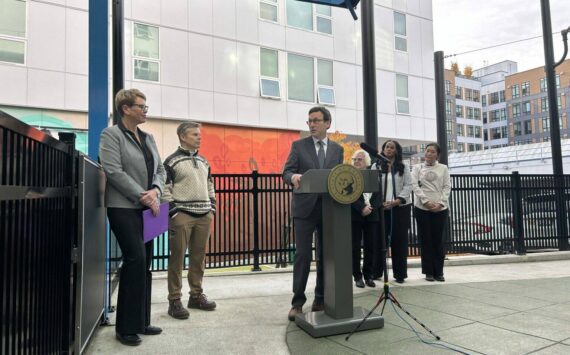Sound Transit, Port of Seattle and the City of SeaTac announced this week a plan for extending light rail service directly to Sea-Tac International Airport by December 2009.
The plan also includes accelerated construction of new roadways that will enhance airport vehicle access and make way for the airports continued expansion.
The plan locates the Central Link light rail airport station on the fourth level of the existing airport parking garage, with an elevated walkway to International Boulevard and a pedestrian connection to the airports ticket counters.
Critics called Central Link the train to nowhere, said Sound Transit Board Chair and Pierce County Executive John Ladenburg. That was in spite of the fact we said there would be direct service to Sea-Tac airport as soon as plans were completed for the expansion of terminals and parking. Now that we know where we can connect with the airport, we can complete the connection. Even better, we can finance the extension with existing revenues and make the connection happen before for the 2010 Winter Olympics in Vancouver!
This is really about three government agencies committed to a goalgetting Sound Transit light rail all the way to the airport, said Port of Seattle Commission Chair and President Paige Miller. It took years of financial, engineering and political work, but we got to a solution that will benefit citizens of the region for a long time.
This plan will speed the departure and arrival of the thousands of travelers and employees who come and go from the airport every day and will spur economic development in the local area, said Mayor Frank Hansen of the City of SeaTac.
The light rail extension and Port of Seattle enabling projects are outlined in agreements Sound Transit CEO Joni Earl signed Monday with Mark Reis, Managing Director of Aviation for the Port, and SeaTac City Manager Bruce Rayburn. In early 2005, the Sound Transit Board and Port of Seattle Commission will act on final agreements assigning detailed responsibilities, timelines and permitting requirements.
Sound Transit outlined a financial plan for covering the estimated $225 million cost of the light rail extension relying entirely on existing revenue sources. The Port of Seattle has financial capacity for the airport and roadway improvements that will enable the light rail extension.
Successful completion of the Sound Transit and Port projects depend on the elimination of congestion at the ramp from the northbound airport expressway to eastbound SR 518. Traffic backups from State Route 518 often extend south of what will become the new Return to Terminal circulation ramp at South 160th Street.
The Port and the State Department of Transportation have been working together for several years on a plan to add about one mile of eastbound lane to SR 518, but it has not yet been funded by the State. While the airport is prepared to partially fund the SR 518 project due to growth in airport traffic on the road, all of the parties will in the coming months explore potential funding sources with the state for that project.
The Port of Seattle, Sound Transit and the City of SeaTac will continue working closely on integrating plans for the light rail connection with the Ports updated plans for expanding the airport. The Ports plan for adding capacity will expand the existing airport terminal to the north and east. Room for the expansion will be created in part by building a new North Airport Expressway, with the light rail alignment running down the center. Sound Transit will provide financial resources to support and complement the City of SeaTacs Transportation Improvement Program by contributing to infrastructure improvements which enhance motor, pedestrian, and bicycle access in areas adjacent to the S. 154th and Airport/City Center light rail stations.
The Port of Seattle projects in the plan include:
*Moving the northbound lane of the airport expressway to the east, so that light rail tracks can be placed in the expressway median;
*Removing the current Return to Terminal ramps at the north end of the airport garage, to be replaced by Sound Transits light rail station; and
*Constructing an interchange at South 160th Street to replace the Return to Terminal ramps, and allow for traffic to re-circulate back to the airport terminal.
In January 2003, the Sound Transit and the Port of Seattle began working in earnest to integrate expansion plans for both Central Link and the airport. When this work began, 2011 was identified as the earliest possible timeframe a light rail extension could be completed. The agencies worked intently to identify options making the December 2009 opening feasible.
Contingent on continuing successes in meeting aggressive planning, design and construction milestones, the plan will establish the direct light rail connection at the end of the same year that the Central Link initial segment is scheduled to open. During the short period prior to completion of the direct airport connection, shuttle buses will meet light rail passengers at the Central Link station at South 154th Street and carry them the remaining 1.7 miles to the airport.
Sound Transit estimates that by 2020 approximately 3,000 riders will use the airport station each day. Travel time between the Airport Station and Downtown Seattle will be 35 minutes.




